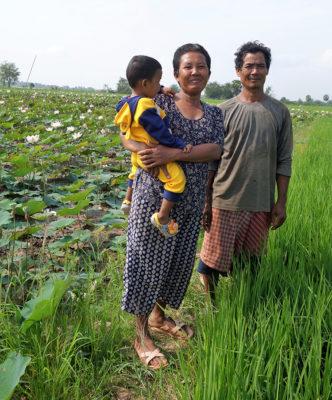December 4, 2020
Climate change adaptation = investment?
Climate change adaptation in private sector financing – but how do you define adaptation and make it an investment case?
Despite all the available information and commitments made for climate change mitigation, the outcomes and trends do not look very promising. Our window to remain below 1.5oC, or even 2oC global temperature increases is becoming very narrow, as my colleague Kenneth Söderling also reminded us in his recent article.
Even though we would manage to fix the course and remain within the targets set in the Paris Agreement, the temperature rise will still require societies to adapt to the impacts of the climate change.
The unfair result is that people who are already most vulnerable and marginalized will also experience the greatest impacts. The poor and particularly women, primarily working in natural resource sectors such as agriculture in developing countries, are expected to be disproportionately affected by climate variability and change.
Wanted: Scalable business models
Until now, climate change mitigation has received far more attention than adaptation. This is possibly because mitigation activities are much easier to describe, monitor and measure. Adaptation activities are very context specific and harder to define with comparable, measurable indicators.
For example, is a microloan provided for a family to upgrade roofing of their house and helping them to stay safe and dry in increasing heavy rains adaptation or grassroot level contribution to SDG 1, No poverty?
Compared to climate change mitigation, funding that is reported to be used for adaptation activities is much less and mainly from public sources, but the search for scalable business models has started in earnest.
Considering that the impacts are already affecting the lives of so many, there should be plenty of local knowledge, experience and ideas on how to adapt to climate change. But where to find the money to fully implement and scale up the ideas?
The UNFCCC report 25 Years of Adaptation Under the UNFCCC estimates that globally rising adaptation costs are likely to range from USD 140 billion to 300 billion per annum by 2030 and could rise to between USD 280 billion and 500 billion per annum by 2050.
It is clear, that public sector funding alone will not be enough to meet all the adaptation needs and voices calling for increased private sector contribution for adaptation funding are raising. But private financiers need to urgently define their contributions as a business case and in terms of measuring their actual adaptation impact before their contributions are counted in.
Partnerships and mechanisms are needed to link the ideas and financing, and public sector support in the form of technical assistance funding for private sector project developers, for example, could help to extract the full potential from the private sector.
Adaptation is a precondition for any business to survive but also a chance to thrive

On the bank of the Tonle Sap River in Cambodia, farming conditions have been poor for the past three years. Microcredits provided by Chamroeun, a microfinance institution financed by Finnfund via BOPA, can provide some protection against bad weather and other unpredictable risks.
However, adaptation is not only potential business for companies and investors. Adaptation is also a precondition for any business to survive. The pressure to adapt comes from the physical changes the climate change will have in companies’ operational environment and also from the likely, but yet often unforeseen regulatory changes.
Firstly, an essential step towards identifying adaptation activities is a climate risk assessment which is increasingly applied in companies and among investors. Significant recognized risks are addressed with adaptation activities, firstly at company level to secure continuity and sustainability i.e. resilience of the business in a changing environment.
Secondly, adaptation may even create a business opportunity meaning that company business activities and/or products can help other businesses and the society to adapt to the climate change.
Climate change can be a driver for innovative solutions and business models. For example, investments which help to better manage water resources under changing climate and weather patterns, droughts and floods, are in the frontline of adaptation. Microfinance institutions, such as Proximity Finance and BOPA-funded Chamrouen build agricultural sector resilience against climate change.
Businesses must understand their wider impacts
Any business needs to understand the wider impacts of their activities on the resilience of the surrounding society and should avoid harming that resilience.
The assessment should be able to recognize the climate change vulnerabilities and how the vulnerability may differ for example between different groups in the society. One necessary element is thus application and integration of the so called ‘gender lens’ in the assessment process.
Risk assessment frameworks and tools exist and new are emerging but alignment and harmonization between actors is necessary to build consensus about the definitions of climate change adaptation in the context of private sector.
Currently, the tools to measure the impacts have been aimed to track the performance of projects designed primarily to foster adaptation – and mainly funded and implemented by public institutions. These tools may not capture all aspects of adaptation in the private sector; we can see that many companies contribute to adaptation and resilience to climate change through their operations even if it is not their core business – sometimes it is something they have not even recognized.
Once the definition for adaptation in private sector has been clarified, it will be easier to develop criteria and indicators, that are context specific and collect comparable data and statistics to assess the impacts and efficiency of financing.
We have rolled our sleeves
So far, EU Taxonomy is the most advanced in framing and setting a common criteria for the adaptation from private sector financing perspective.
Yet, even the Taxonomy acknowledges that “as measured baselines or accepted metrics for adaptation have not yet been developed, an established methodology for defining quantitative screening criteria for adaptation and defined adaptation targets at the national, sectoral, or subnational level do not exist.
The EU Taxonomy is most welcomed as an initiative to frame adaptation in private sector even though it has been developed and will be applied to businesses operating within the EU boundaries.
At this point, instead of falling into despair in front of the complexities around adaptation, we remember a message from the World Resources Institute: “Ultimately, adaptation is about doing development differently in response to climate change.”
In Finnfund we have rolled our sleeves to pin the challenges of climate risks, climate change adaptation and resilience. Our commitments are sharpened in a Climate and energy statement to be released in early 2021, and we are currently working on our climate risk assessment framework and tools, and seek collaboration and coordination with other European Financing Institutes and other partners with a shared interest in this work.
Stay tuned!
Anne Arvola
Development Impact Advisor, Finnfund
Comments
Comments are closed.

Great post on the difficulties of climate adaption investment. Were the tools under development released?
“Our commitments are sharpened in a Climate and energy statement to be released in early 2021, and we are currently working on our climate risk assessment framework and tools, and seek collaboration and coordination with other European Financing Institutes and other partners with a shared interest in this work.”
Thank you for your comment! We are currently piloting the framework and the tools and will soon share some of the first experiences on our website. We will also explain the framework and the tools in more detail. However, the actual tools will not be publicly available